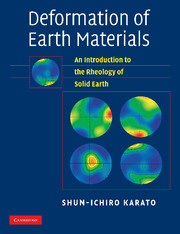Book contents
- Frontmatter
- Contents
- Preface
- Part I General background
- Part II Materials science of deformation
- Part III Geological and geophysical applications
- 17 Composition and structure of Earth's interior
- 18 Inference of rheological structure of Earth from time-dependent deformation
- 19 Inference of rheological structure of Earth from mineral physics
- 20 Heterogeneity of Earth structure and its geodynamic implications
- 21 Seismic anisotropy and its geodynamic implications
- References
- Materials index
- Subject index
- Plate section
21 - Seismic anisotropy and its geodynamic implications
Published online by Cambridge University Press: 05 June 2012
- Frontmatter
- Contents
- Preface
- Part I General background
- Part II Materials science of deformation
- Part III Geological and geophysical applications
- 17 Composition and structure of Earth's interior
- 18 Inference of rheological structure of Earth from time-dependent deformation
- 19 Inference of rheological structure of Earth from mineral physics
- 20 Heterogeneity of Earth structure and its geodynamic implications
- 21 Seismic anisotropy and its geodynamic implications
- References
- Materials index
- Subject index
- Plate section
Summary
Earth materials are anisotropic to some extent and the nature of anisotropic structures can be inferred from a range of seismological observations. Anisotropic structures carry valuable information as to the anisotropic fields that reflect the dynamic processes in Earth's interior including the geometry of flow. Therefore seismic anisotropy provides an important insight into the dynamics of Earth's interior. However, both observations and the interpretation of seismic anisotropy are not straightforward. Following the description of some of the fundamentals of seismic wave propagation in an anisotropic material, I will review the basic seismological observations on anisotropy. This is followed by a brief summary of the essence of the processes that may cause anisotropic structure formation. They include lattice-preferred orientation of anisotropic crystals and shape-preferred orientation of (isotropic or anisotropic) materials with distinct elastic moduli (or other types of layered structure). In most cases, seismic anisotropy is caused by lattice-preferred orientation of elastically anisotropic minerals. The relation between seismic anisotropy and deformation in such a case is mineral specific, and also depends on the physical and chemical conditions that change the elastic and plastic anisotropy of minerals. Following detailed discussions on the mechanisms of lattice-preferred orientation and other microscopic processes of anisotropic structure formation, some geodynamic implications of seismic anisotropy are discussed in the final section.
Key words azimuthal anisotropy, polarization anisotropy, shear wave splitting, Christoffel equation, lattice-preferred orientation, shape-preferred orientation.
- Type
- Chapter
- Information
- Deformation of Earth MaterialsAn Introduction to the Rheology of Solid Earth, pp. 391 - 411Publisher: Cambridge University PressPrint publication year: 2008
- 2
- Cited by



